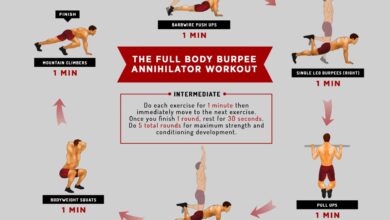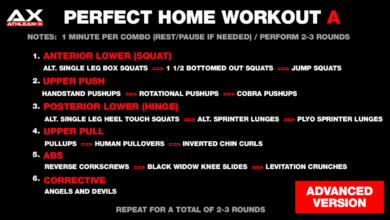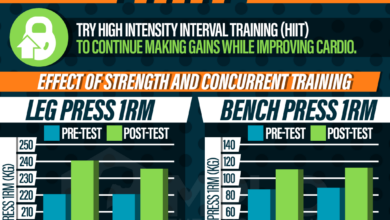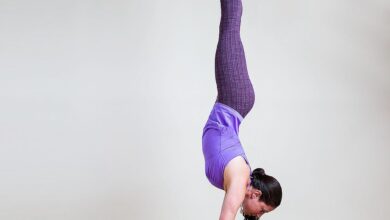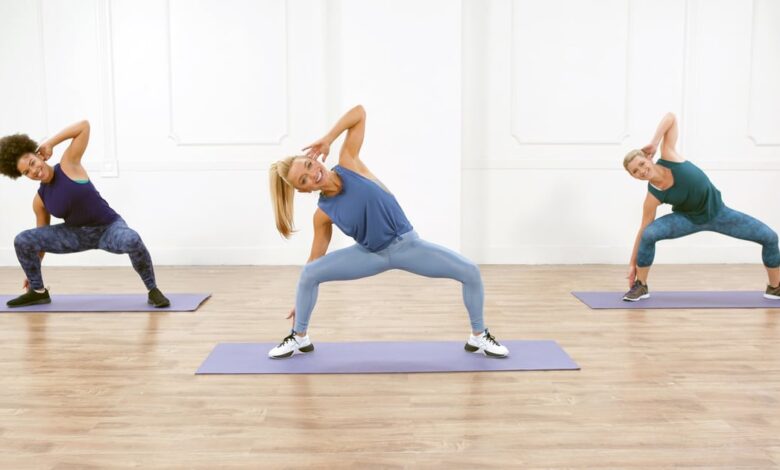
Cardio Workouts You Can Do in 30 Minutes or Less
Cardio workouts you can do in 30 minutes or less are a game-changer for busy individuals looking to improve their fitness. These short, high-intensity workouts offer a powerful way to burn calories, boost cardiovascular health, and enhance overall well-being.
Whether you’re a seasoned athlete or just starting your fitness journey, incorporating these efficient workouts into your routine can make a significant difference in your health and energy levels.
This guide will explore a variety of cardio workouts, from high-intensity interval training (HIIT) to bodyweight exercises, and even using cardio machines. We’ll delve into the benefits of each type of workout, provide specific routines, and offer tips for beginners.
So, if you’re ready to squeeze in a great workout without sacrificing precious time, let’s dive in!
Cardio Workouts: 30 Minutes or Less
Cardiovascular exercise, often referred to as cardio, is a crucial component of a well-rounded fitness routine. It involves activities that elevate your heart rate and improve your cardiovascular health. Engaging in regular cardio workouts offers numerous benefits, including improved heart health, weight management, increased energy levels, and enhanced mood.For individuals with busy schedules, the thought of dedicating an hour or more to a workout can seem daunting.
However, incorporating short, high-intensity workouts into your routine can be just as effective as longer, moderate-intensity sessions. These bursts of intense activity can deliver significant fitness gains in a fraction of the time.
Types of Cardio Exercises for Short Workouts
Short, high-intensity cardio workouts can be performed in various ways. The following are some examples of exercises that can be incorporated into a 30-minute or less routine:
- High-Intensity Interval Training (HIIT):This involves alternating between short bursts of intense exercise and brief recovery periods. Examples include sprinting, jumping jacks, burpees, and mountain climbers.
- Tabata Training:This is a specific form of HIIT that involves 20 seconds of intense exercise followed by 10 seconds of rest, repeated eight times for a total of four minutes.
- Circuit Training:This involves performing a series of exercises in a circuit, with minimal rest between each exercise. This can be customized to include various cardio exercises, such as jumping rope, running in place, and high knees.
- Running or Jogging:Even a short run or jog can provide a great cardio workout. If you have limited time, you can opt for a brisk walk or a combination of walking and running intervals.
- Cycling:Cycling is a low-impact cardio exercise that can be done indoors or outdoors. You can choose to ride at a moderate pace or incorporate interval training for a more intense workout.
- Swimming:Swimming is an excellent full-body cardio workout that is low-impact and suitable for people of all fitness levels.
High-Intensity Interval Training (HIIT)
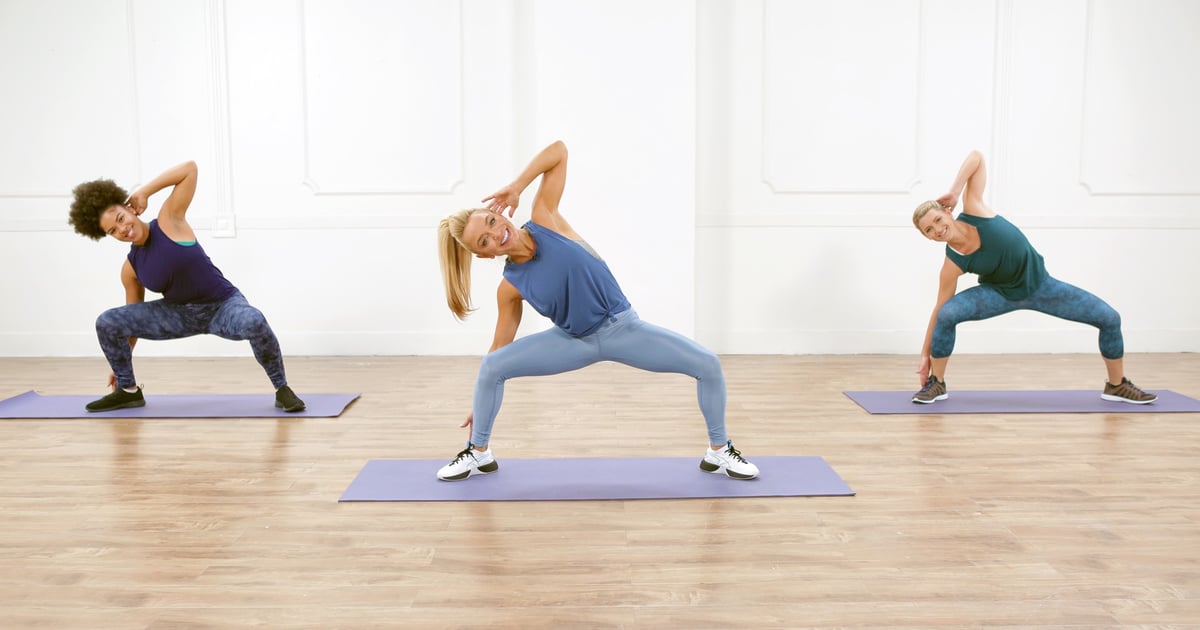
High-Intensity Interval Training (HIIT) is a popular form of exercise that alternates between short bursts of intense activity and brief recovery periods. It’s known for its effectiveness in burning calories, improving cardiovascular health, and boosting metabolism.
Principles of HIIT
HIIT workouts are structured around the concept of pushing your body to its limits for short periods, followed by periods of rest or low-intensity activity. This cyclical pattern helps maximize calorie expenditure and improve cardiovascular fitness.
Effectiveness of HIIT
HIIT has been proven to be highly effective for burning calories and improving cardiovascular health. Studies have shown that HIIT can lead to greater fat loss compared to traditional steady-state cardio, even when performed for shorter durations. It also improves heart rate variability, increases VO2 max (maximum oxygen uptake), and enhances insulin sensitivity.
HIIT Workout Examples
Here are some examples of HIIT workouts that can be completed in 30 minutes or less:
Bodyweight HIIT Workouts
- Workout 1:
- 20 seconds of jumping jacks
- 10 seconds of rest
- 20 seconds of burpees
- 10 seconds of rest
- 20 seconds of high knees
- 10 seconds of rest
- 20 seconds of mountain climbers
- 10 seconds of rest
Repeat this circuit 3-4 times.
- Workout 2:
- 30 seconds of push-ups
- 30 seconds of rest
- 30 seconds of squats
- 30 seconds of rest
- 30 seconds of lunges (alternate legs)
- 30 seconds of rest
Repeat this circuit 2-3 times.
Equipment-Based HIIT Workouts
- Workout 1:
- 30 seconds of sprinting on a treadmill
- 30 seconds of walking on a treadmill
- 30 seconds of rowing
- 30 seconds of rest
Repeat this circuit 3-4 times.
- Workout 2:
- 30 seconds of jumping rope
- 30 seconds of rest
- 30 seconds of kettlebell swings
- 30 seconds of rest
Repeat this circuit 3-4 times.
Sample HIIT Workout Schedule
Here is a sample HIIT workout schedule that alternates between high-intensity bursts and recovery periods:
| Exercise | Duration | Intensity |
|---|---|---|
| Jumping jacks | 30 seconds | High |
| Rest | 30 seconds | Low |
| Burpees | 30 seconds | High |
| Rest | 30 seconds | Low |
| Mountain climbers | 30 seconds | High |
| Rest | 30 seconds | Low |
Repeat this circuit 3-4 times.
Tips for HIIT Workouts
- Warm up:Before starting a HIIT workout, it’s essential to warm up your muscles for 5-10 minutes with light cardio and dynamic stretching.
- Listen to your body:If you feel pain, stop the exercise and rest. Don’t push yourself beyond your limits.
- Stay hydrated:Drink plenty of water before, during, and after your workout.
- Cool down:After your HIIT workout, cool down with 5-10 minutes of light cardio and static stretching.
Cardio Machines: Cardio Workouts You Can Do In 30 Minutes Or Less
Cardio machines offer a convenient and effective way to get a good workout in, whether you’re at home or at the gym. They provide a structured and controlled environment for cardio exercise, allowing you to track your progress and adjust the intensity to suit your fitness level.
Thirty minutes is all you need for a killer cardio workout! Whether it’s a brisk walk, a jog around the block, or a high-intensity interval training session, getting your heart rate up is crucial for overall health. And hey, after that workout, you might be craving a cheesy treat.
But don’t worry, you can still indulge in a grilled cheese sandwich without feeling guilty! Check out this article to learn how to make a healthy and satisfying grilled cheese. Remember, balance is key, so enjoy your treat in moderation and get back to those awesome cardio workouts!
Benefits of Cardio Machines
The benefits of using cardio machines include:
- Improved cardiovascular health:Regular cardio exercise strengthens your heart and lungs, reducing your risk of heart disease, stroke, and other cardiovascular problems.
- Weight management:Cardio machines burn calories, which can help you lose weight or maintain a healthy weight.
- Increased endurance:Using cardio machines can improve your stamina and ability to perform physical activities for longer periods.
- Reduced risk of chronic diseases:Regular cardio exercise can lower your risk of developing chronic diseases such as type 2 diabetes, certain types of cancer, and osteoporosis.
- Improved mood and mental health:Cardio exercise releases endorphins, which have mood-boosting effects. It can also help reduce stress and anxiety.
Drawbacks of Cardio Machines
While cardio machines offer many benefits, they also have some drawbacks:
- Repetitive nature:Using cardio machines can be repetitive, which can make it boring for some people.
- Joint impact:Some cardio machines, such as treadmills, can put stress on your joints, especially if you have pre-existing conditions.
- Cost:Cardio machines can be expensive to purchase, especially if you’re looking for a high-quality machine.
- Space requirements:Cardio machines can take up a significant amount of space, especially if you’re using them at home.
Adjusting Intensity and Duration
The intensity and duration of your cardio workouts on machines should be adjusted based on your fitness level and goals.
- Intensity:You can adjust the intensity of your workout by changing the speed, incline, or resistance on the machine.
- Duration:You can adjust the duration of your workout by changing the amount of time you spend on the machine.
Workout Routine
Here is a sample 30-minute cardio workout routine that combines different machines and intervals:
Warm-up:5 minutes on the elliptical at a moderate intensity.
Interval 1:5 minutes on the treadmill at a brisk pace.
Interval 2:5 minutes on the stationary bike at a moderate resistance.
Interval 3:5 minutes on the elliptical at a high intensity.
Interval 4:5 minutes on the treadmill at a moderate pace.
Finding time for a quick cardio workout can be tough, but even 30 minutes can make a difference! If you’re looking for some inspiration, try a HIIT session, a brisk walk, or even some jumping jacks. And when you’re done, you can reward yourself with a delicious meal cooked in your trusty Dutch oven – there are amazing things to do with a Dutch oven beyond just stews and roasts.
Remember, a little bit of exercise goes a long way, and a good meal makes everything better!
Cool-down:5 minutes on the stationary bike at a low resistance.
This routine can be adjusted to suit your fitness level and goals. You can increase the intensity or duration of the intervals as you get fitter. You can also switch up the order of the machines to keep your workouts interesting.
Bodyweight Cardio Exercises
Bodyweight cardio exercises are a great way to get a full-body workout without needing any equipment. They can be done anywhere, anytime, and are perfect for people of all fitness levels. These exercises are particularly beneficial for beginners as they help build a strong foundation for more advanced workouts.
Sometimes, squeezing in a quick cardio workout feels like a mission impossible. But even a 30-minute burst can make a difference. And speaking of making the most of your time, have you ever considered turning last night’s leftovers into a delicious breakfast?
Check out 5 ways turn last nights leftovers mornings breakfast for some creative ideas. Once you’ve tackled your morning meal, you’ll be ready to tackle that 30-minute cardio session!
Bodyweight Cardio Exercises
Bodyweight cardio exercises engage multiple muscle groups, improving cardiovascular health, and burning calories. Here are some effective exercises you can incorporate into your routine:
- Jumping Jacks:This classic exercise works your entire body, especially your legs and core. Stand with your feet together and arms at your sides. Jump while spreading your legs slightly wider than shoulder-width apart and raising your arms overhead. Return to the starting position and repeat.
- Burpees:This full-body exercise combines a squat, push-up, and jump. Start standing, then squat down and place your hands on the floor in front of you. Kick your feet back into a plank position, perform a push-up, and then return to the plank.
Bring your feet back to the squat position and jump up, raising your arms overhead.
- High Knees:This exercise focuses on your legs and core. Stand with your feet hip-width apart and lift your knees as high as you can towards your chest. Pump your arms to help drive the movement.
- Mountain Climbers:This exercise engages your core, legs, and shoulders. Start in a plank position with your hands shoulder-width apart. Bring one knee towards your chest, then quickly switch legs. Keep your core engaged and maintain a straight back throughout the exercise.
- Butt Kicks:This exercise targets your hamstrings and glutes. Stand with your feet hip-width apart and bring your heels up towards your glutes. Keep your core engaged and maintain a straight back throughout the exercise.
- Squat Jumps:This exercise combines a squat with a jump, working your legs and core. Stand with your feet shoulder-width apart and lower your body into a squat position, keeping your back straight. Push off the ground and jump up, extending your arms overhead.
Land softly on your feet and repeat.
30-Minute Bodyweight Cardio Workout, Cardio workouts you can do in 30 minutes or less
This workout can be done three to four times a week. Be sure to warm up for five minutes before starting and cool down for five minutes afterward.
- Warm-up:5 minutes of light cardio, such as walking or jogging in place.
- Round 1:
- Jumping Jacks: 30 seconds
- Burpees: 30 seconds
- High Knees: 30 seconds
- Mountain Climbers: 30 seconds
- Rest: 30 seconds
- Round 2:
- Jumping Jacks: 30 seconds
- Burpees: 30 seconds
- High Knees: 30 seconds
- Mountain Climbers: 30 seconds
- Rest: 30 seconds
- Round 3:
- Jumping Jacks: 30 seconds
- Burpees: 30 seconds
- High Knees: 30 seconds
- Mountain Climbers: 30 seconds
- Rest: 30 seconds
- Cool-down:5 minutes of stretching.
Proper Form and Technique
Proper form is essential for maximizing the benefits of bodyweight cardio exercises and preventing injuries. Here are some tips for maintaining good form:
- Engage your core:Keeping your core engaged throughout each exercise will help stabilize your body and prevent injuries.
- Maintain a straight back:Avoid rounding your back, especially during exercises like burpees and mountain climbers.
- Land softly:When jumping, land softly on your feet to avoid putting stress on your joints.
- Listen to your body:If you feel any pain, stop the exercise and consult a doctor or certified personal trainer.
Cardio for Beginners
Starting a cardio journey can be exciting, but it’s important to approach it with a beginner’s mindset. Remember, consistency is key, and gradual progression is more sustainable than pushing yourself too hard too soon. This section will provide you with modifications, tips, and a beginner-friendly routine to help you get started.
Modifications and Variations for Beginners
It’s essential to make cardio exercises accessible and enjoyable for beginners. Here are some modifications and variations:
- Walking:Instead of running, begin with brisk walking. You can gradually increase the pace and duration as you feel comfortable.
- Modified Jumping Jacks:Instead of jumping, simply step your feet out to the sides and then back in. You can also reduce the height of the steps.
- Chair Squats:Stand in front of a sturdy chair with your feet shoulder-width apart. Lower your body as if you were about to sit down, but stop just before your thighs are parallel to the floor. Push back up to the starting position.
- Modified Push-Ups:Start with wall push-ups, where you lean against a wall and push your body away. As you gain strength, you can progress to incline push-ups using a bench or a table.
- Swimming:Swimming is a low-impact cardio exercise that is gentle on your joints. You can start with swimming laps at a slow pace and gradually increase the distance and intensity.
Tips for Staying Motivated and Avoiding Burnout
Staying motivated is crucial for beginners. Here are some tips:
- Find an Activity You Enjoy:Choose a cardio activity that you genuinely like. This will make it more likely that you’ll stick with it.
- Set Realistic Goals:Don’t aim for too much too soon. Start with small, achievable goals and gradually increase the intensity and duration of your workouts.
- Listen to Your Body:Pay attention to your body’s signals and rest when you need to. Don’t push yourself beyond your limits.
- Make It Social:Workout with a friend or join a fitness class. This can provide motivation and support.
- Track Your Progress:Keep a journal or use a fitness tracker to track your progress. This can help you stay motivated and see how far you’ve come.
Beginner-Friendly 30-Minute Cardio Workout Routine
This routine can be done 3-4 times per week:
- Warm-up:5 minutes of light cardio, such as brisk walking or marching in place.
- Cardio:
- 10 minutes of brisk walking
- 5 minutes of jumping jacks (modified or regular)
- 5 minutes of chair squats
- 5 minutes of high knees (modified or regular)
- Cool-down:5 minutes of stretching.
As you progress, you can gradually increase the intensity and duration of your workouts. For example, you can increase the pace of your walking, add more repetitions of each exercise, or extend the workout time.
Closure
Finding time for fitness can be a challenge, but with a little planning and commitment, incorporating cardio workouts into your routine can be surprisingly manageable. Remember, consistency is key. Start small, gradually increase the intensity and duration of your workouts, and listen to your body.
And don’t forget to have fun! Choose exercises you enjoy, and you’ll be more likely to stick with it. So, get moving, and experience the incredible benefits of regular cardio workouts, even if you only have 30 minutes or less to spare.

